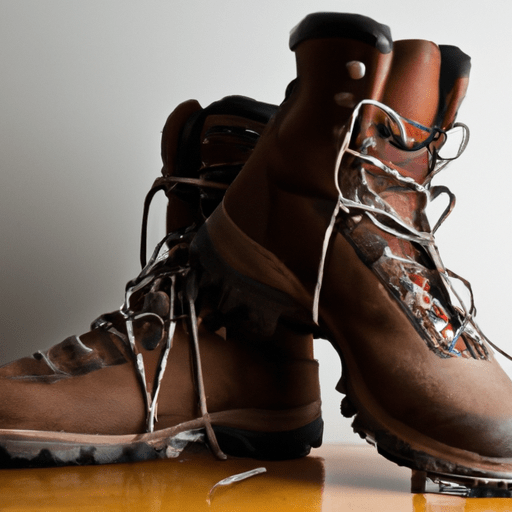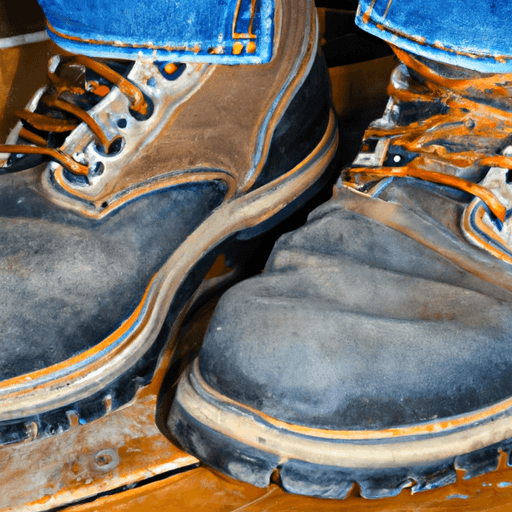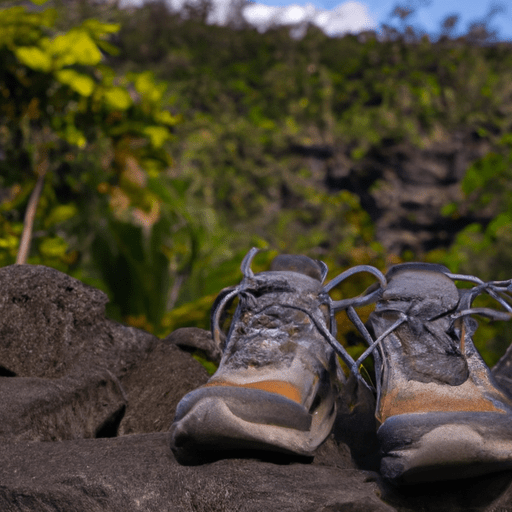Imagine embarking on a rugged outdoor adventure and the crucial decision of whether to lace up your sturdy hunting boots or strap on your trusty hiking boots. In this comprehensive comparison, we will delve into the unique features and benefits of both types of footwear, giving you the tools to make an informed choice based on your specific needs and terrain. Strap in tight and get ready to explore the ultimate showdown: hunting boots vs hiking boots.
Construction and Durability
Materials Used
When it comes to the construction and durability of hunting boots and hiking boots, one important factor to consider is the materials used. Hunting boots are typically made from sturdy and durable materials such as full-grain leather or synthetic materials like Cordura nylon. These materials provide excellent protection against rugged terrains and harsh weather conditions. On the other hand, hiking boots are often made with a combination of leather and synthetic materials, which strike a balance between durability and flexibility.
Stitching Quality
Another aspect of construction to consider is the stitching quality of the boots. For both hunting and hiking boots, it is essential to have high-quality stitching that can withstand the demands of outdoor activities. Look for boots with reinforced stitching and double or triple stitching in high-stress areas. This will ensure that the boots hold up well over time and don’t easily come apart during your adventures.
Projected Lifespan
When investing in a pair of boots, it’s important to consider their projected lifespan. Hunting boots, designed for rugged use and long-lasting durability, often have a longer lifespan compared to hiking boots. This is mainly due to the materials used and the overall construction. Hiking boots, while durable, may have a shorter lifespan due to the lighter materials and design focused on comfort and flexibility.
Ruggedness for Various Terrains
Both hunting boots and hiking boots are designed to offer excellent performance in various terrains. Hunting boots, typically built for traversing challenging and rough terrains, often feature a more rugged design with aggressive tread patterns and reinforced toe caps. Hiking boots, on the other hand, are designed to handle uneven trails, rocky surfaces, and challenging inclines while providing greater comfort and flexibility.
Comfort and Fit
Size and Fit Differences
When it comes to comfort and fit, one of the most crucial aspects is finding the right size for your feet. Both hunting boots and hiking boots come in various sizes, but it’s essential to pay attention to any specific differences. Some hunting boots may run slightly larger or have a wider fit to accommodate thicker socks or additional insulation layers. Hiking boots, on the other hand, may have a more snug fit to provide better support and prevent blisters during long hikes.
Footbed Design
The footbed design is another factor that affects the comfort of hunting and hiking boots. A well-designed footbed can help distribute pressure and provide support, reducing foot fatigue during long hours of walking or standing. Many hunting boots feature specialized footbeds with arch support and cushioning that adapt to the contours of the foot. Hiking boots often have removable footbeds that allow for customization and accommodate orthotics if needed.
Ankle Support
Ankle support is crucial, especially during rugged outdoor activities. Hunting boots typically offer higher ankle support, with taller shafts that provide stability and protection against twisted ankles. This becomes particularly important when navigating through uneven and rocky terrains. Hiking boots also offer ankle support but are often lower-cut to allow for greater flexibility and freedom of movement.
Break-in Period
One thing to keep in mind when considering comfort is the break-in period required for the boots. Hunting boots, with their sturdier materials, may require a longer break-in period compared to hiking boots. This is because they need time to mold to your feet, ensuring a proper fit and reducing the likelihood of blisters or discomfort. Hiking boots, with their lighter and more flexible materials, typically have a shorter break-in period, allowing you to hit the trails with greater comfort sooner.
Weather Resistance
Waterproofing
Weather resistance is a crucial factor to consider when choosing between hunting boots and hiking boots. Both types of boots often offer waterproofing features, but the level of waterproofing can vary. Hunting boots, designed for use in wet and muddy environments, often have more advanced waterproof membranes such as Gore-Tex. This ensures that your feet stay dry even when crossing streams or walking through wet vegetation. Hiking boots also offer varying degrees of waterproofing but may not be as heavy-duty as hunting boots.
Insulation for Cold Weather
For those venturing into colder climates, insulation is an important consideration. Hunting boots often come with additional insulation to keep your feet warm in freezing temperatures. Thinsulate or other specialized insulation materials are commonly used in hunting boots to provide warmth without adding excessive bulk. Hiking boots, while designed for more temperate conditions, may offer some insulation features but are generally not as heavily insulated as hunting boots.
Breathability in Warm Weather
When it comes to warm weather conditions, breathability becomes crucial to ensure comfort. Hiking boots are typically designed with better breathability in mind, allowing air circulation and reducing the build-up of moisture inside the boots. This helps prevent sweat and discomfort during long hikes in hot weather. Hunting boots, while still providing some level of breathability, may not offer the same level of ventilation due to their emphasis on durability and insulation.
Design and Aesthetics
Stylistic Differences
Design and aesthetics play a role in the choice between hunting boots and hiking boots. Hunting boots often have a more rugged and utilitarian design, focusing primarily on performance and durability. They may feature camouflage patterns, earthy tones, or other designs that blend in with natural environments. Hiking boots, on the other hand, often have a more versatile and stylish design, with a range of colors and patterns that cater to different preferences.
Color Variations
Both hunting boots and hiking boots come in various color options. Hunting boots often feature earthy tones, such as browns, greens, or camouflage patterns, to blend in with the surroundings during hunting expeditions. Hiking boots, while still offering neutral color options, also come in brighter colors to cater to different fashion preferences. Ultimately, the choice of color comes down to personal preference and the intended use of the boots.
Utility vs Style Consideration
When considering the design and aesthetics of hunting and hiking boots, it’s essential to strike a balance between utility and style. Hunting boots prioritize utility, focusing on features that enhance performance and durability. Hiking boots, while still offering performance-driven features, often place more emphasis on style, allowing hikers to express their personal taste while enjoying the outdoors. Consider your priorities and the specific context in which you will be using the boots to make the best choice for you.
Weight and Portability
Weight Comparison
The weight of the boots can significantly impact your overall comfort and mobility during outdoor activities. Hunting boots tend to be heavier due to the sturdier materials and additional insulation. This can provide extra protection and warmth but may also result in a heavier load on your feet. Hiking boots, designed for extended periods of walking, are often lighter in weight, allowing for greater agility and reducing fatigue during long hikes.
Impact on Mobility
The weight of the boots directly affects your mobility and maneuverability in various terrains. Lighter hiking boots provide greater flexibility and allow for quicker movements, making them suitable for activities that require agility, such as trail running or scrambling over rocks. Hunting boots, while heavier, provide better stability and support on uneven surfaces, making them preferred for rugged terrains and hunting scenarios that require slower, methodical movements.
Ease of Packing and Transport
Another aspect of weight and portability to consider is how easily the boots can be packed and transported. Hiking boots, with their lighter weight and more flexible construction, are generally easier to pack and take up less space in a backpack or luggage. This is particularly important for travelers and backpackers who need to conserve space. Hunting boots, while bulkier, are often designed to withstand rough handling and can be strapped to the outside of a backpack if necessary.
Soles and Traction
Sole Material
The material used for the soles of hunting and hiking boots plays a significant role in the overall traction and durability. Hunting boots often feature thicker and sturdier soles, typically made of rubber or synthetic materials that offer excellent grip on various surfaces. These soles are designed to withstand the demands of hunting scenarios, including slippery terrains and rocky slopes. Hiking boots typically have lighter and more flexible soles, emphasizing comfort and shock absorption while still providing good traction.
Tread Design
The tread design of the soles is crucial for maintaining traction and preventing slips and falls. Hunting boots often feature aggressive tread patterns with deep lugs that provide excellent grip on muddy and uneven terrains. This is especially important for hunters who need to maintain stability in unpredictable situations. Hiking boots also offer varying tread designs, with some models focusing on multi-directional lugs for improved grip on diverse terrains, while others prioritize smoother sole designs for better contact on flat and rocky surfaces.
Grip on Various Surfaces
The overall grip and traction of the boots on different surfaces are essential for safety and confidence during outdoor activities. Hunting boots, with their thicker soles and aggressive tread patterns, excel in providing traction on muddy, slippery, and uneven terrains. This makes them ideal for hunting scenarios that often involve traversing challenging environments. Hiking boots, while still offering reliable grip, may not perform as well in extremely muddy conditions or steep slopes but are generally sufficient for most hiking trails and terrains.
Purpose and Application
Hiking Scenario Usage
Hiking boots are specifically designed for hiking and excel in this specific outdoor activity. They are lightweight, comfortable, and provide the necessary support and grip for various terrains encountered during hikes. Hiking boots are suitable for day hikes, multi-day backpacking trips, and other activities that require extended periods of walking. They are designed to withstand the demands of uneven trails, rocky surfaces, and steep inclines while providing the necessary comfort and protection.
Hunting Scenario Usage
Hunting boots are tailored for the specific needs of hunters. They are sturdy, durable, and designed to withstand rugged terrains and harsh weather conditions. Hunting boots offer excellent ankle support, insulation, and waterproofing features, making them suitable for long hours spent in the field or forest. Additionally, hunting boots often incorporate camouflage patterns or earthy tones to blend in with the surroundings and minimize visibility to game animals.
Cross-over Possibilities and Limitations
While hiking boots and hunting boots are designed for specific activities, there can be some crossover in their usage. Hiking boots can be used for hunting in scenarios where lighter, more flexible footwear is suitable and when additional insulation or camouflage is not required. Similarly, hunting boots can be used for hiking, particularly in rugged terrains where ankle support and extra durability are necessary. However, it’s important to consider the specific requirements of each activity and determine if the boots can meet those needs adequately.
Maintenance and Care
Cleaning Procedures
Proper maintenance and care are essential for prolonging the lifespan of your boots and ensuring their optimal performance. Cleaning hunting and hiking boots regularly is important to remove dirt, mud, and other debris that can accumulate over time. Use a soft brush or cloth to remove loose dirt, then use a mild detergent or boot-specific cleaner to gently scrub away any stains. Rinse thoroughly with clean water and allow them to air dry. Avoid using harsh chemicals or soaking the boots for prolonged periods, as this can damage the materials.
Repairing Potential Damages
Despite their durability, both hunting and hiking boots can experience wear and tear over time. It’s important to address any potential damages promptly to prevent further deterioration. For minor damages such as loose stitching or small tears, you can use specialized boot repair materials or adhesives to fix them. For major damages, such as sole separation or significant tears, it’s best to consult a professional cobbler or contact the manufacturer for appropriate repair options.
Preservation Techniques for Longevity
To ensure the longevity of your boots, it’s crucial to implement preservation techniques. Applying a waterproofing treatment periodically can help maintain the boots’ waterproof capabilities and protect them from excessive moisture. Conditioning the leather portions of the boots with a suitable leather conditioner can help keep the material supple and prevent cracking. Storing the boots in a cool, dry place away from direct sunlight can also prolong their lifespan.
Prices and Value for Money
Price Range Comparison
The price range of hunting boots and hiking boots can vary depending on factors such as brand, materials used, and additional features. Generally, hunting boots tend to be more expensive due to their specialized design and emphasis on durability and performance. Hiking boots, while still offering high-quality construction and features, often come at a more affordable price point. It’s important to consider your budget and the specific requirements of your outdoor activities when determining the value for money.
Cost vs Durability
When comparing the cost versus durability, hunting boots often offer better long-term value. They are built with sturdier materials and construction techniques that can withstand harsh conditions and frequent use. Hiking boots, while providing durability for their intended purpose, may not have the same level of ruggedness and longevity as hunting boots. However, the overall value for money also depends on your individual needs, usage frequency, and preferences.
Investment Outlook Based on Usage Frequency
If you are an avid outdoors enthusiast who frequently engages in hunting or hiking activities, investing in a high-quality pair of boots is a wise decision. While the initial cost may be higher, the long-term durability and performance benefits can outweigh the expense. On the other hand, if you participate in outdoor activities less frequently or have a limited budget, opting for a mid-range hiking boot that meets your basic requirements can still provide satisfactory performance and value for money.
Brands and Quality
Popular Brands for Hiking Boots
There are several reputable brands known for their high-quality hiking boots. Some popular options include Merrell, Salomon, Columbia, Vasque, and Keen. These brands have established themselves as leaders in the outdoor footwear industry, offering a wide range of hiking boots that cater to different preferences and needs. When choosing a brand, consider factors such as reputation, customer reviews, and specific features that align with your hiking requirements.
Popular Brands for Hunting Boots
For hunting boots, brands that specialize in outdoor and hunting footwear are often the go-to choices. Some renowned brands in this category include Danner, LaCrosse, Irish Setter, Rocky, and Muck Boot. These brands offer hunting boots specifically designed to withstand rugged terrains, harsh weather conditions, and extended hours in the field. Look for features such as insulation, waterproofing, and durability when considering hunting boot brands.
Brand Reputation & Reliability
Brand reputation and reliability are essential considerations when investing in outdoor footwear. Reputable brands have often built their names on consistent quality, reliability, and customer satisfaction. They prioritize the use of high-quality materials, employ robust construction techniques, and thoroughly test their products to ensure they meet the demands of outdoor enthusiasts. Reading customer reviews and researching the brand’s history and commitment to quality can help you make an informed decision when choosing between hunting and hiking boots.
In conclusion, both hunting boots and hiking boots offer unique features and benefits tailored to specific outdoor activities. Consider factors such as materials used, construction quality, comfort, weather resistance, design preferences, and price range when making your choice. Ultimately, finding the right pair of boots that cater to your needs and preferences will enhance your outdoor experiences and provide reliable protection and performance. Happy adventures!









